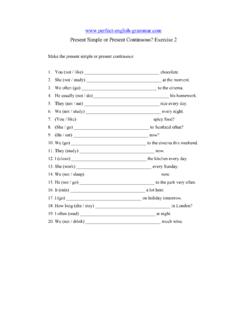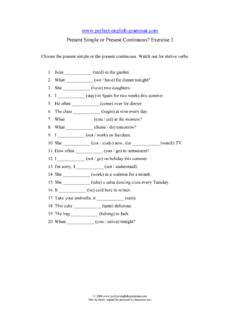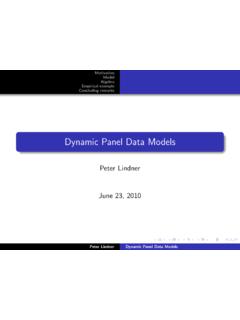Transcription of AN INTRODUCTION TO SOURCE SAMPLING - LEVEGO
1 AN INTRODUCTION TO SOURCE SAMPLING Presented by Gerald Woollatt LEVEGO Stationary SOURCE Emission Measurement Specialists Particulate Matter vs. Gaseous Emissions SOURCE emissions classified broadly into Isokinetic SAMPLING for particulate matter and non-isokinetic SAMPLING for gaseous emissions When do we need to sample? Emission Data can be used: Government To provide data for determining appropriate emission limits. To provide data for determining compliance. To provide data for health risk assessments.
2 To provide data for dispersion modeling. Emission Data can be used: Industry (continued) To evaluate air pollution control equipment. To provide information for design of new process and control equipment. To provide information on process operations. Isokinetic Measurement of SOURCE Emissions: Particulate emissions from a SOURCE are sampled isokinetically using a recognized international standard such as US EPA Method 5 SAMPLING train. The collected sample is analyzed to determine the pollutant concentrations.
3 Isokinetic SAMPLING Misconceptions about Isokinetic SAMPLING It is not a quick, simple exercise - fairly involved and complex Time consuming - setting up equipment, preliminary checks etc. Specifically used for determining flue gas particulate concentrations in a duct or stack Equipment specifically designed for Isokinetic SAMPLING Isokinetic SAMPLING ISOKINETIC Iso similar or the same Kinetic Moving energy, motion Isokinetic SAMPLING ISOKINETIC SAMPLING DEFINITION SAMPLING at such a rate that the velocity and the direction of the gas entering the SAMPLING Nozzle is the same as that of the gas in the duct/stack at the same SAMPLING point Isokinetic SAMPLING Schematic of Method 5 SAMPLING Train Isokinetic SAMPLING Typical SAMPLING location and equipment Isokinetic SAMPLING (continued) Isokinetic SAMPLING (continued)
4 Cross Section of Measurement Position Isokinetic SAMPLING Purpose of SAMPLING Isokinetically The main objective of Isokinetic SAMPLING is to acquire a representative sample of flue gas particulate concentrations Isokinetic SAMPLING Factors that Necessitate the Need for Isokinetic SAMPLING Physical properties of particulates in the gas stream - density, shape, size etc. Heterogeneous nature of particulate mixture in gas stream Uneven distribution of particles in gas stream turbulence, gravity etc.
5 Isokinetic SAMPLING Identifying a Proper SAMPLING Location ISO, EPA, BS etc. provide requirements for selecting proper sample locations Specific minimum requirements set out by ISO9096- No. of SAMPLING ports, Distance from fans or bends in system, no. of SAMPLING points required. Above minimum requirements are dependant on the duct size Preliminary velocity to determine suitability of sample location Isokinetic SAMPLING Determining SAMPLING Points Concept of dividing duct in equal areas Need to sample at the minimum number of SAMPLING points set out by the standard in order to get a proper representative sample due to uneven distribution of particles in gas stream No.
6 Of points depends on size of duct Isokinetic SAMPLING Diagrammatic Representation of SAMPLING Points in a Duct/Stack Isokinetic SAMPLING Errors Associated with not SAMPLING Isokinetically OVER SAMPLING Can result in an Increase or decrease in particulate concentration. This is due to not SAMPLING Isokinetically by SAMPLING above the flue gas rate Isokinetic SAMPLING UNDER SAMPLING Can result in an increase or decrease in particulate concentration. This is due to not SAMPLING Isokinetically by SAMPLING below the flue gas rate Isokinetic SAMPLING (continued) Under SAMPLING vs.
7 Over SAMPLING UNDER SAMPLING High pressure created at nozzle Large particles tend to follow normal path Small particles will be more easily moved from their original path thus being deflected around the nozzle Lower percentage of smaller particles collected Not representative of particulate dust burdens or distribution OVER SAMPLING Low pressure created at nozzle Large particles tend to follow normal path Small particles will be more easily moved from their original path thus being directed into the nozzle Higher percentage of smaller particles collected Not representative of particulate dust burdens or distribution Isokinetic SAMPLING Over SAMPLING and Under SAMPLING Associated Errors that could Influence SAMPLING Accuracy Moisture Gas Composition Nozzle.
8 Probe direction Leakages on test equipment Test equipment not calibrated Non- compliance to minimum requirements of relevant standard Not collecting enough particulate matter Unstable Process conditions Isokinetic SAMPLING Theoretical Example Stack Monitoring 2 m diameter According to ISO 9096 - Two sample ports and twelve points with a minimum SAMPLING time of three minutes per point Time required minimum 36 minutes per test excl. travel, pre-test preparation, set up Minimum of three tests required Additional analyses could result in an increase in test period particle size analyses, low particulate matter concentrations Isokinetic SAMPLING Gaseous SAMPLING Principles Homogenous nature of gases - therefore not necessary to sample Isokinetically - this is because Flue gases are presumed to mix thoroughly, Very small molecules therefore not adversely affected by gravity.
9 Properties of gases are such that a sample can be taken at several predetermined points along the diameter of the duct and still be representative with out having to sample Isokinetically Gaseous SAMPLING The sample is taken at a set flow rate, at each point throughout the duct 1l/min A Velocity measurement is performed in conjunction with the tests The velocity measurement is used to calculate the emission rate of the gas sampled Time, Temperature, Contact time, Surface area, affinity of the gas etc.
10 All effect the SAMPLING time and nature of reagents used when SAMPLING for a specific gas and therefore have to be taken into consideration Gaseous SAMPLING continued Interferences Moisture- Many gases are absorbed by moisture, sample line must be heated in most instances HF, Volatile organics etc. Other gases present in the gas stream may interfere with SAMPLING reagents. Certain materials in the SAMPLING line may interfere with certain gases acid gases may react with stainless steel present in the SAMPLING line Gaseous SAMPLING S T A C K Probe with filtration Heated Line Heated Manifold conditioning unit / condenser VOC s / UHC s Analyser (O2, CO2, CO, SO2, NO, NO2) Non heated line Gaseous SAMPLING Relevant Standards used in South Africa Air Pollution is currently governed by the National Environmental Management: Air Quality Act (AQA) No.







